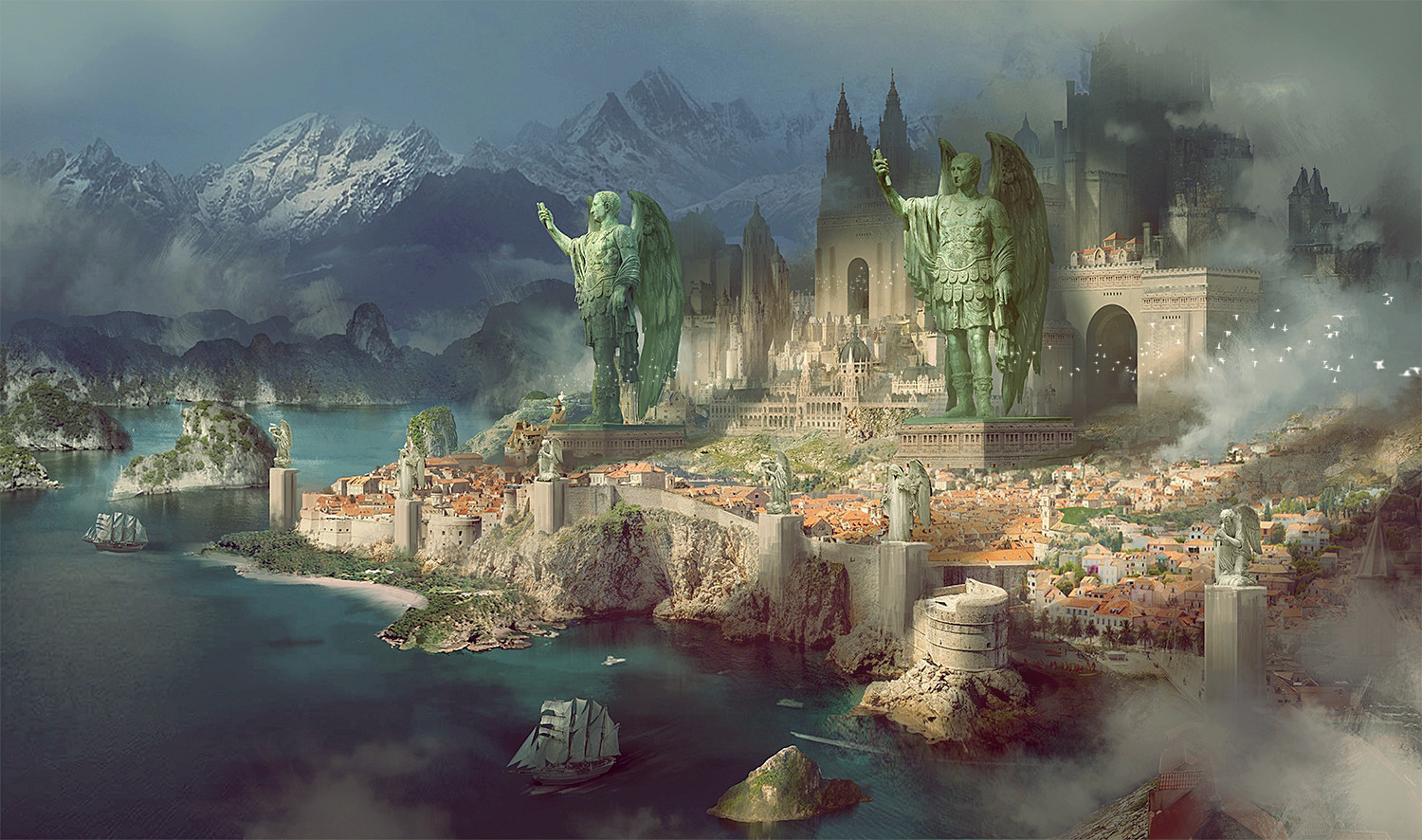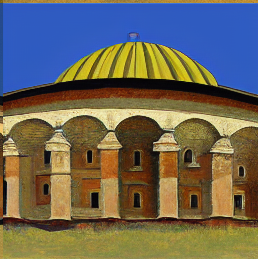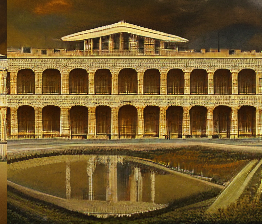Palace of the Blatian Emperors
Never has existed in the world such a building that emanates such splendour and majesty. Never has a ruler inhabited and ruled the world from such a magnificent placeConsidered the most beautiful and majestic of all the Palaces of Yeia, the Imperial Palace in Blati is perhaps the most famous building in the continent of Teria, and even beyond. It’s situated at the acropolis of the imperial capital and dominates the landscape of Blati. It is also the last bastion of defence in case the city is attack and its mighty walls cannot repel the invaders. Inside it, there is the Great Temple ( the Blatian Empire's holiest place), two libraries, an stadium, a polo field, three bath houses, a theatre and the barracks of the Imperial Guard, among other buildings. You can access the Imperial palace from the great avenue, the Krunia after passing the two giant temples dedicated to the deified Emperors. But only those who have received an invitation or are close to power can enter its sacred walls and be in the presence of the Regent of the Gods on Earth, the divine Son of the Goddess of Thunder.
Origins
The palace first palace complex was built by the Ikarian Emperor Claudius I in 325 BP when Blati became the summer residence for the Imperial family and the court. As the city of Blati grew so did the palace and its magnificence. New buildings like the baths and one of the libraries were added by subsequent emperors in the first centuries AP. But the palace as we know it today really took shape after the fall of the Ikarian Empire in 460 AP when Blati became the capital of the Blatian Empire, one of the successor states of the fallen Ikarian realm ruled by the descendants of the last Ikarian Emperor. In 490 AP the Great Temple, dedicated to all the gods was built as a copy of the homonymous temple in Ikaria, now vandalized and almost destroyed by the barbarians. Its walls are covered in golden mosaics and chryselephantine statues of the gods near the altar. New baths, a theatre and a library were built by emperor Anastasius III in 560 AP. And in 630 AP the stadium and the polo fields were built by emperor Claudius IV with the gold paid by the barbarians from the north. He also built the famous Pompteianion ("5 doors" in Ikarian) chamber, that would become the throne room and where the Emperor attends court and receive commoners and foreign dignitaries. Empresses also played an important role in the building and expansion of the palace. For instance, Empress Popilia built the Gardens of Eternal Happiness (inspired by the ones at Ymhilean and Sakouramish while the Empress of Nari origin, Amika built the Silver Pavilion, overlooking the city and planted a big cherry-tree that could be seen in all its glory from the lower city during spring. .Famous buildings and artworks
- Pompteianion: Meaning "5 doors" in Ikarian. It is the throne room of the Palace. Is a rounded chamber and its roofs and its dome are made of gold and its walls are covered by silver plates and mosaics depicting the gods and past Ikarian Emperors. The throne is made of gold and so it is made the roof that covers it. Alongside the walls its written a quote attribute to the goddess Zerah that says: "These are my sons, who will never be slaves as to them has been given by me and my divine father the right to rule over all peoples". There is a statue of a lion that, through hidden engines powered by water, roars, scaring foreign delegations.
- Library of Anastasius III: Though not as big and famous as the Great Library found in the lower city, near the Forum, it contains quite a fascinating collection of books collected by many emperors in the past. Here you can find books of many subjects and from all the corners of the known world. Many of them are direct copies of those stored at the great library.
- Gardens of Eternal Happiness: Quite a peculiar name for a garden; it was built by Empress Popilia (although her real name was Podami, as she was a seris princess). Its inspired by the gardens found at the Seris capital, Sakouramish, as well as the gardens of the royal sun elf palace at Ymhilean, where her mother was from. She chose this name in honor of a garden at Sakouramish called the Garden of the Golden Crane that was also called the Garden of Perpetual Grace. In the middle of the gardens lies a fountain that depicted the myth of the competition between the goddess Zerah and Pyra that ultimated created the Suris Strait. The statues of the fountain are made of gold and where designed by the famous Blatian sculptor Marcianus of Dubria.
- Silver Pavilion and great big cherry-tree: it overlooks the city and its usually where the emperors and empresses go for relaxing during their resting time. Here great poems and paintings have been created under the shadow of the great cherry-tree. For example a painting of empress Amika writing a poem under the tree was painted by the Oronai painter Perdiccas of Phagias that today hangs in the Imperial bedrooms.
Ceremonies and court routine inside the Palace
Life in the Imperial palace follows a set of routine patterns. At sunrise bells began to ring from one of the towers of the Palace's walls signing the time to everybody to get up, take a bath and prepare for their daily activities. It also marks the change of the guard. One hour after the bells rang, the Emperor and his family have breakfasts and, after they finished, they pray before the altar of the goddess of Thunder, Zerah. Then the emperor goes to his office where in company of the chamberlain, called the Master of Offices he ratifies the new laws and supervises the new building projects of the Empire. At midday the Rigas and his family have lunch usually watching a theatrical play or hearing a bard. From 3 PM to 4 PM there is a period called "Resting time", where the nobles at court and the Imperial family retire to their rooms for resting, reading a book, or whatever other relaxing activities. After 4 AM the emperor and its court resume their activities. The Emperor helds audiences at the Pompteianion while the bureaucracy writes imperial edicts, letters from the Emperor, new laws etc... . At 7AM those who want may go to the baths or to the polo field to play a game. Usually, each month a Great Tournament of Polo is held at the Palace, and also each month and specially during the most important religious festivals Theatrical plays are also performed at the imperial residence. Finally, at 9 PM the Rigas and its court goes to the Great Temple to attend the liturgy and perform the libations to the gods and after this they hold a dinner banquet and finally go to sleep around 11-12 PM. Also the Imperial palace is the place where many grandiose ceremonies are held. For example, during the feast of Zeraiah in honour of the goddess of thunder, the statue of the goddess is transported in procession around the city and its finally placed at the great temple during the whole duration of the festival. The procession is presided by the Emperor dressed in his most luxurious purple clothes covered with pearls, followed by the rest of his family, escorted by the imperial guard (also in their finest parade uniforms), the Senators and the priests of the goddess. Cheers and chants in honour of the Emperor and the goddess by the people can be heard through the procession. When the Statue of the Goddess reach the Great Temple at the Imperial Palace fireworks are shot from the walls of the Palace.The Importance and influence of the Building in the rest of the world
From the Blatians the Rigasaion or Rigasdomi ("House of the Emperor") is considered almost as a sacred place. Its the home of what they believed is the Gods's Regent on Earth, its Viceroy on the mortal realm, and also the direct descendant of the Goddess of Thunder ( All Blatians are her descendants according to myth but on a different level). Here is where the sacred sceptre with its orb containing the power of thunder is store. And according to tradition, if the orb is in Blati and doesn't fall into enemy hands the Empire will be saved. The sacrest ceremonies are performed at the Great Temple at the Palace. The sacred relics given by the gods to the Ikarians (that could be saved from the fall of Ikaria) are stored there. Also the Rigasaion has been the model for literally every royal palace in the continent of Teria due to the power and influence of the Blatian Empire. For example, the Oronai royal palaces of Evergetia, Boria on the Delta and Phagias are based on the Blatian Imperial Palace (specially the one at Boria on the Delta, designed by Boros The Conqueror who had been a guest at the Rigasaion in his youth) , as well as the royal palaces at the capitals of Witarfia and Wesdaland. The Grand Duke of Liwal even made a throne room like the Pompteianion, but instead of golden roofs, he built ones made of silver. So, the Palace of the Blatian Emperors became the ultimate symbol of power and majesty both to the Blatians themselves and for the rest of the nations under the culture influence of the Blatians. It has captivated the imagination of every king, duke and chieftain in the continent with legends of its splendour and beauty.
Founding Date
325 BP
Type
Palace
Ruling/Owning Rank
Owning Organization






Comments